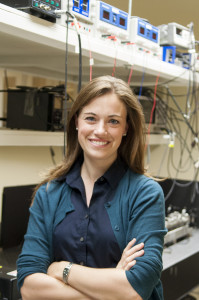Brianna Mount, Black Hills State University – Dark Matter
 How much do you know about neutrinos?
How much do you know about neutrinos?
Dr. Brianna Mount, a research assistant professor in physics at Black Hills State University, explains her research into this mysterious facet of our universe.
Dr. Brianna Mount is a research assistant professor in physics at Black Hills State University. She received her PhD from Florida State University. Her current research centers around underground science, particularly at the Sanford Underground Research Facility in Lead, SD.
Dark Matter

What is dark matter? It makes up 85% of the matter in the universe, but we don’t know what it is. What is the nature of the neutrino? Although there are 100 trillion passing through our bodies a second, we know relatively little about this elusive particle. These are fundamental physics questions being studied at the Sanford Lab in South Dakota. The experiments that will hopefully answer these questions fall under the category of what physicists call “rare event searches.” The events these experiments are searching for are expected to only occur a few times a year. However, the detectors we build to detect the rare events are very sensitive to cosmic rays on the surface of the earth, which bombard us all day, every day and would completely overwhelm our rare-event signal. To solve this problem, we go a mile underground at the Sanford Lab, where the rock above us shields us from cosmic rays.
The tiniest amounts of radioactive elements in the very materials we use to construct our experiments can also overwhelm the rare-event signal. To give you an idea of the amounts we’re talking about, human sweat is too radioactive. To solve this problem, the our Underground Campus will house detectors physicists can use to screen materials used in rare-event searches. These detectors work by identifying the ionizing radiation released from a radioactive decay of elements such as uranium and thorium.
Another way to detect low amounts of radioactive elements in substances is to use a technique called Inductively Coupled Plasma Mass Spectrometry. This instrument ionizes samples of materials, then sends the ions through a magnetic field and watches how they bend to determine how much of certain elements are contained in the sample.
The dark matter and neutrino rare-event searches are reliant on these techniques for constructing their detectors. These techniques are looking for the tiniest amounts of radioactive elements in the construction materials for some of the biggest physics experiments of our time.



Just great to see so many young women involved, and getting experience in, the sciences. Great video.